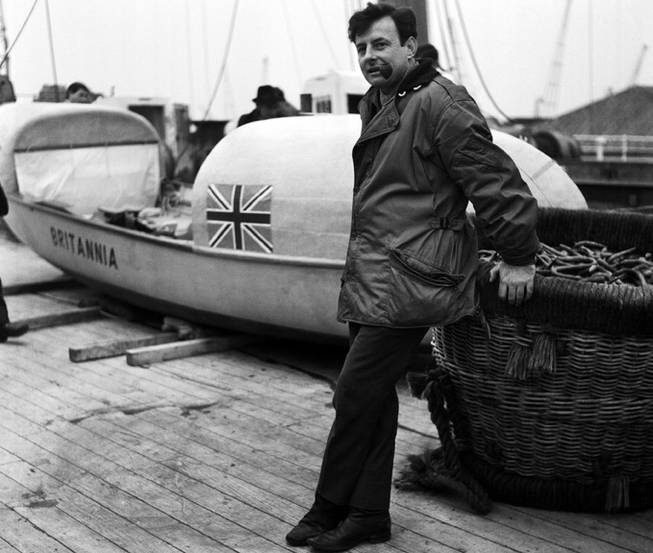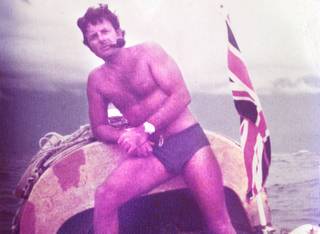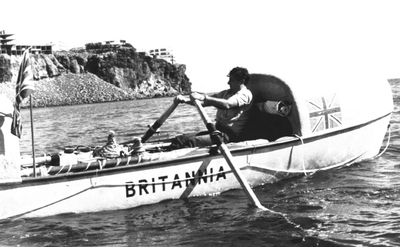
ASSOCIATED PRESS
In this Jan. 3, 1969, file photo, John Fairfax stands beside his 22-foot rowing boat, Britannia, at a dock in London before sailing to the Canary Islands from where he planned to row across the Atlantic to Miami. Fairfax, the first known person to row alone across the Atlantic Ocean, died at his Henderson home at age 74.
Saturday, Feb. 25, 2012 | 2 a.m.
He crossed the Atlantic because it was there, and the Pacific because it was also there.
He made both crossings in a rowboat because it, too, was there, and because the lure of sea, spray and sinew, and the history-making chance to traverse two oceans without steam or sail, proved irresistible.
In 1969, after six months alone on the Atlantic battling storms, sharks and encroaching madness, John Fairfax, who died this month at 74, became the first lone oarsman in recorded history to traverse any ocean.
In 1972, he and his girlfriend, Sylvia Cook, sharing a boat, became the first people to row across the Pacific, a yearlong ordeal during which their craft was thought lost. (The couple survived the voyage, and so, for quite some time, did their romance.)
Both journeys were the subject of fevered coverage by the news media. They inspired two memoirs by Fairfax, “Britannia: Rowing Alone Across the Atlantic” and, with Cook, “Oars Across the Pacific,” both published in the early 1970s.
Fairfax died Feb. 8 at his home in Henderson. The apparent cause was a heart attack, said his wife, Tiffany. A professional astrologer, she is his only immediate survivor. Cook, who became an upholsterer and spent the rest of her life quietly on dry land (though she remained a close friend of Fairfax), lives outside London.
For all its bravura, Fairfax’s seafaring almost pales beside his earlier ventures. Footloose and handsome, he was a flesh-and-blood character out of Graham Greene, with more than a dash of Ernest Hemingway and Ian Fleming.
At 13, he lit out for the Amazon jungle.
At 20, he attempted suicide by jaguar. Afterward, he was apprenticed to a pirate. To please his mother, who did not take kindly to his being a pirate, he briefly managed a mink farm, one of the few truly dull entries on his otherwise crackling resume.
Fairfax was among the last avatars of a centuries-old figure: the lone-wolf explorer, whose exploits are conceived to satisfy few but himself. His was a solitary, contemplative art that has been all but lost amid the contrived derring-do of adventure-based reality television.
The only child of an English father and a Bulgarian mother, Fairfax was born on May 21, 1937, in Rome, where his mother had family; he scarcely knew his father, who worked in London for the BBC.
Seeking to give her son structure, his mother enrolled him at 6 in the Italian Boy Scouts. It was there, Fairfax said, that he acquired his love of nature — and his determination to bend it to his will.
On a camping trip when he was 9, Fairfax concluded a fight with another boy by filching the scoutmaster’s pistol and shooting up the campsite. No one was injured, but his scouting career was over.
His parents’ marriage dissolved soon afterward, and he moved with his mother to Buenos Aires. A bright, impassioned dreamer, he devoured tales of adventure, including an account of the voyage of Frank Samuelsen and George Harbo, Norwegians who in 1896 were the first to row across the Atlantic. Fairfax vowed he would one day make the crossing alone.
At 13, in thrall to Tarzan, he ran away from home to live in the jungle. He survived there as a trapper with the aid of local peasants, returning to town periodically to sell the jaguar and ocelot skins he had collected.
He later studied literature and philosophy at a university in Buenos Aires and at 20, despondent over a failed love affair, resolved to kill himself by letting a jaguar attack him. When the planned confrontation ensued, however, reason prevailed — as did the gun he had with him.
In Panama, he met a pirate, applied for a job as an apprentice and was taken on. He spent three years smuggling guns, liquor and cigarettes around the world, becoming captain of one of his boss’ boats, work that gave him superb navigational skills.
When piracy lost its luster, he gave his boss the slip and fetched up in 1960s London, at loose ends. He revived his boyhood dream of crossing the ocean and, since his pirate duties had entailed no rowing, he began to train.
He rowed daily on the Serpentine, the lake in Hyde Park.
On Jan. 20, 1969, Fairfax pushed off from the Canary Islands, bound for Florida. His 22-foot craft, the Britannia, was the Rolls-Royce of rowboats: Made of mahogany, it had been created for the voyage by the eminent English boat designer Uffa Fox. It was self-righting, self-bailing and partly covered.
Aboard were provisions (Spam, oatmeal, brandy), water and a temperamental radio. There was no support boat and no chase plane — only Fairfax and the sea. He caught fish and sometimes boarded passing ships to cadge food, water and showers.
The long, empty days spawned a temporary madness. Desperate for female company, he talked ardently to the planet Venus.
On July 19, 1969 — Day 180 — Fairfax, tanned, tired and about 20 pounds lighter, made landfall at Hollywood, Fla.
“This is bloody stupid,” he said as he came ashore. Two years later, he was at it again.
This time, Cook, a secretary and competitive rower he had met in London, was aboard. Their new boat, the Britannia II, also a Fox design, was about 36 feet long, large enough for two though still little more than a toy on the Pacific.
“He’s always been a gambler,” Cook, 73, recalled by telephone. “He was going to the casino every night when I met him — it was craps in those days. And at the end of the day, adventures are a kind of gamble, aren’t they?”
Their crossing, from San Francisco to Hayman Island, Australia, took 361 days — from April 26, 1971, to April 22, 1972 – and was an 8,000-mile cornucopia of disaster.
“It was very, very rough, and our rudder got snapped clean off,” Cook said. “We were frequently swamped, and at night you didn’t know if the boat was the right way up or the wrong way up.”
Fairfax and Cook became trapped in a cyclone, lashing themselves to the boat until it subsided. Unreachable by radio for a time, they were presumed lost.
For all that, Cook said, there were abundant pleasures.
Fairfax was often asked why he chose a rowboat to beard two roiling oceans.
“Almost anybody with a little bit of know-how can sail,” he said in a profile on the website of the Ocean Rowing Society International, which adjudicates ocean rowing records. “I’m after a battle with nature, primitive and raw.”



Join the Discussion:
Check this out for a full explanation of our conversion to the LiveFyre commenting system and instructions on how to sign up for an account.
Full comments policy